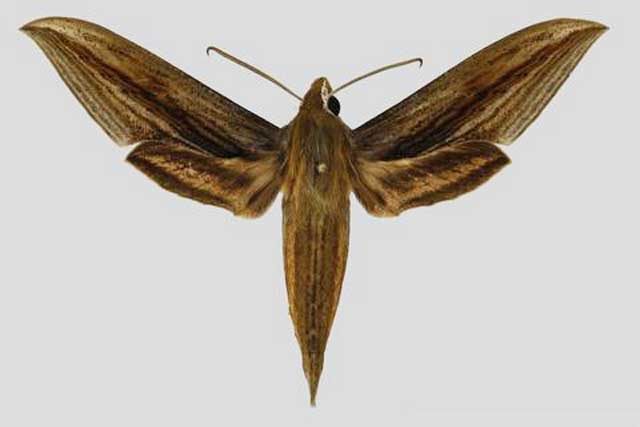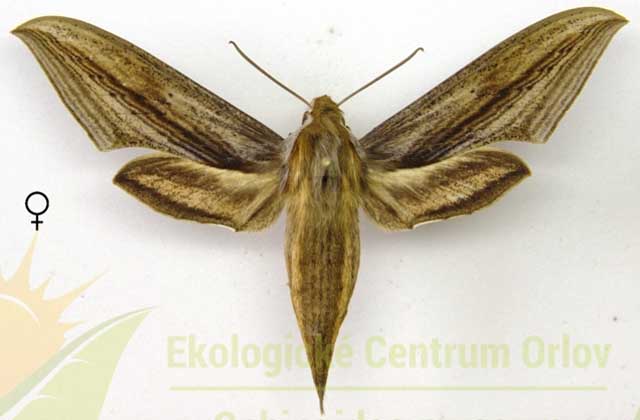Xylophanes monzoni
http://sphingidae.myspecies.info/taxonomy/term/3005
Sphingidae Museum, Czech Republic
Xylophanes monzoni
zail-AH-fan-eesM
MON-zon-eye
Haxaire & Eitschberger, 2003

Xylophanes monzoni male, Santa Rosa, Baja Verapaz, Guatemala,
courtesy of Jean Haxaire; http://sphingidae.myspecies.info/taxonomy/term/3005
This site has been created by Bill Oehlke. Comments, suggestions and/or additional information are welcomed by Bill.
TAXONOMY:
Family: Sphingidae, Latreille, 1802
Subfamily: Macroglossinae, Harris, 1839
Tribe: Macroglossini, Harris, 1839
Genus: Xylophanes Boisduval, 1852 ...........
Species: monzoni Haxaire & Eitschberger, 2003
|
DISTRIBUTION:
Xylophanes monzoni, [wingspan: males: mm, females: 78mm // forewing length: males: 41mm; females larger] flies in
Guatemala: Huehuetenango; Baja Verapaz;
Mexico: Chiapas; Yucatan; Quintana Roo;
Belize;
Honduras.
Wiki: "The length of the forewings is about 41 millimetres (1.6 in). It is similar to Xylophanes falco, but generally darker, with a more diffuse pattern and
less falcate forewings. Furthermore, the underside of the abdomen is lacking the two longitudinal grey lines. The forewing upperside is similar but the pale
brown-beige area basad of the postmedian lines is covered with scattered black scales. The distal median line is almost reaching the discal spot, the basalmost
postmedian line is straight and the postmedian and submarginal lines are less conspicuous against the ground colour. The submarginal and marginal bands are both
very dark grey, almost black."
FLIGHT TIMES:
Xylophanes monzoni adults fly in November in Guatemala. There are probably additional flight months.
ECLOSION:
Pupae probably wiggle to surface from subterranean chambers just prior to eclosion.

Xylophanes monzoni female, Guatemala,
courtesy of Sphingidae Museum, Czech Republic.
SCENTING AND MATING:Females call in the males with a pheromone released from a gland at the tip of the abdomen.
The pronunciation of scientific names is troublesome for many. The "suggestion" at the top of the page is merely a suggestion. It is based on
commonly accepted English pronunciation of Greek names and/or some fairly well accepted "rules" for latinized scientific names.
The suggested pronunciations, on this page and on other pages, are primarily put forward to assist those who hear with internal ears as they read.
There are many collectors from different countries whose intonations and accents would be different.
Jean Marie Cadiou writes, "When I say "Xylophanes" in English I pronounce it something like "Zailophanees", with the emphasis on the
"o". The French pronounce it differently, something like "Kzeelophaness" with no emphasis, and the Germans yet in a different way..."
In Greek myth, Phanes is the golden winged Primordial Being who was hatched from the shining Cosmic Egg that was the source of the
universe. He personifies light emerging from chaos.
"Xylo" is the Greek word for wood.
The specimen type for the genus Xylophanes is Xylophanes anubus. Perhaps ? when Hubner
examined that species, the yellow-orange and brown tones of the forewings suggested wings of wood.
The species name "monzoni" is honourific for Jose Monzon.
Use your browser "Back" button to return to the previous page.
Goto Main Sphingidae Index
Goto Macroglossini Tribe
Goto Central American Indices
Goto Carribean Islands
Goto South American Indices
Goto U.S.A. tables
Use your browser "Back" button to return to the previous page.
This page is brought to you by Bill Oehlke and the
WLSS. Pages are on space rented from Bizland. If you would like to become a "Patron of the Sphingidae Site", contact Bill.
Please send sightings/images to Bill. I will do my best to respond to requests for identification help.
Enjoy one of nature's wonderments: Live
Saturniidae (Giant Silkmoth) cocoons.
 | 
Show appreciation for this site by clicking on flashing butterfly to the left.
The link will take you to a page with links to many insect sites. |



